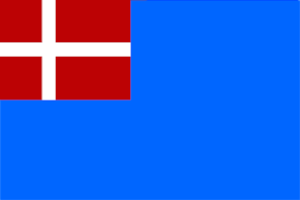
Flag
*The Danish West Indies, also known as the Danish Antilles or the Danish Virgin Islands, was a Danish colony in the Caribbean, affirmed on this date in 1672.
It consists of the islands of Saint Thomas, Saint John, and Saint Croix. The economy of the Danish West Indies functioned and prospered because of slave labor from the Middle Passage. Merchants established a West Indian trading company in 1622. On January 25, 1625, an eight-year monopoly on trade with the West Indies, Virginia, Brazil, and Guinea was granted. The failure of the Danish East India and Iceland Companies and the beginning of Danish involvement in the Thirty Years' War dried up any interest in the idea.
Prince Frederick organized unsuccessful trading missions to Barbados in 1647 and 1651. It was not until Erik Smit's successful private 1652 expedition that interest in the West Indies trade became an interest in creating a new Danish colony. Smit was named governor. Settlers departed, but the ship hit two significant storms, a fire, and raids by English privateers. Smit died of illness, and the second band of buccaneers stole the boat and used it to trade with neighboring islands. The Danish West India Company annexed the island of Saint Thomas in 1672 and St. John in 1718. In 1733, Saint Croix was purchased from the French West India Company.
When the Danish company went bankrupt in 1754, the King of Denmark–Norway assumed direct control of the three islands. Britain occupied the Danish West Indies in 1801–02 and 1807–15 during the Napoleonic Wars. Danish colonizers in the West Indies aimed to exploit the profitable triangular trade, exporting firearms and other manufactured goods to Africa in exchange for slaves, who were then transported to the Caribbean to work the sugar plantations. Caribbean colonies, in turn, exported sugar, rum, and molasses to Denmark. The economy of the Danish West Indies depended on slavery.
After a rebellion, slavery was officially abolished in 1848, leading to the near economic collapse of the plantations. In 1852, the Danish parliament first debated the sale of the increasingly unprofitable colony. Denmark tried several times to sell or exchange the Danish West Indies to the United States and the German Empire in the late 19th and early 20th centuries. The islands were bought for 25 million dollars by the United States, which took over the administration on March 31, 1917, renaming the islands the United States Virgin Islands. Water Island was part of the Danish West Indies until 1905 when the Danish state sold it to the East Asiatic Company, a private shipping company.